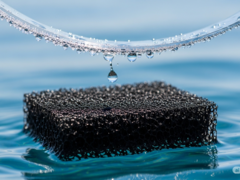In our world today, a majority of the population rely on groundwater for their drinking water. The drilling of boreholes is largely unregulated and undocumented, despite the potential impact of these boreholes. The adoption of seawater desalination can help control and mitigate the impact of excessive drilling.
The new material discovered by researchers at the Hong Kong Polytechnic University is a step forward in the direction of reducing human dependency on groundwater. With an increase in size, the material managed less than 5% reduction in performance, whereas traditional evaporators experience over 40% drop in performance.
The new aerogel features 20-micrometer vertical holes uniformly spread across its surface. To make this aerogel, the researchers 3D-printed a paste consisting of carbon nanotubes and cellulose nanofiber layer by layer unto a frozen material.
To test the efficiency of the new material, the researchers conducted indoor and outdoor tests with the material at varying scales. For the tests, they used square-shaped aerogel materials between 1 and 8 centimeters (0.39 and 3.15 inches).
Our aerogel allows full-capacity desalination at any size, providing a simple, scalable solution for energy-free desalination to produce clean water. — Xi Shen, Lead Researcher.
The process is simple — the carbon-based aerogel floats in a cup of seawater, when exposed to sunlight, its surface heats up, causing water to separate from salt and evaporate. This fresh water vapor then condenses on the underside of a transparent cover, where it is collected as purified, drinkable water. In a proof-of-concept outdoor test, the system successfully produced about three tablespoons of fresh water in six hours.
Source(s)
ACS Energy Letters via ACS Newsroom, ResearchGate, and USGS: 1 and 2

















